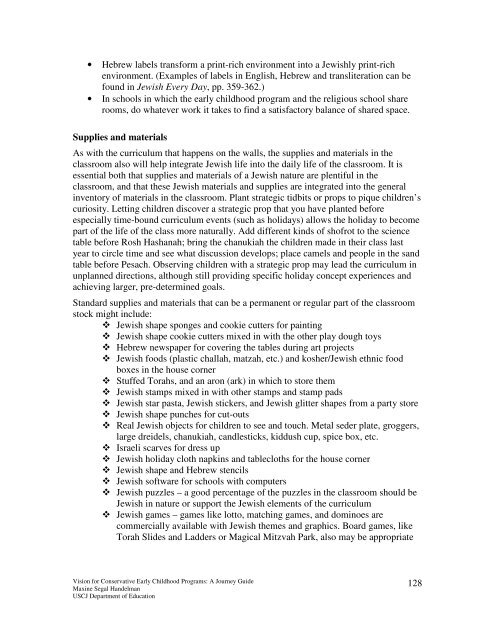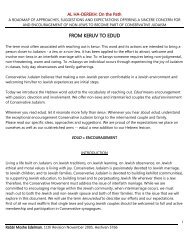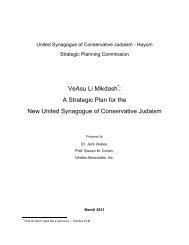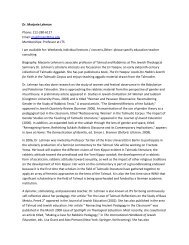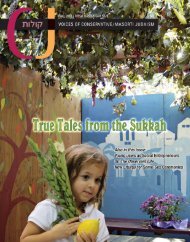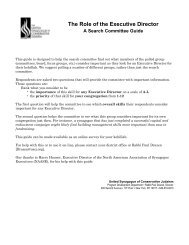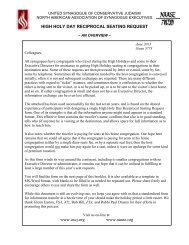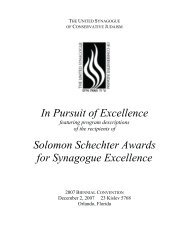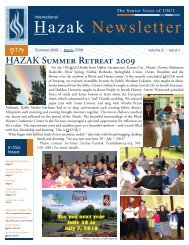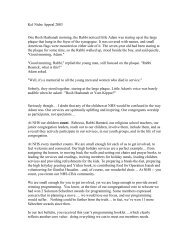Vision for Conservative Early Childhood Programs: A Journey Guide
Vision for Conservative Early Childhood Programs: A Journey Guide
Vision for Conservative Early Childhood Programs: A Journey Guide
Create successful ePaper yourself
Turn your PDF publications into a flip-book with our unique Google optimized e-Paper software.
• Hebrew labels trans<strong>for</strong>m a print-rich environment into a Jewishly print-rich<br />
environment. (Examples of labels in English, Hebrew and transliteration can be<br />
found in Jewish Every Day, pp. 359-362.)<br />
• In schools in which the early childhood program and the religious school share<br />
rooms, do whatever work it takes to find a satisfactory balance of shared space.<br />
Supplies and materials<br />
As with the curriculum that happens on the walls, the supplies and materials in the<br />
classroom also will help integrate Jewish life into the daily life of the classroom. It is<br />
essential both that supplies and materials of a Jewish nature are plentiful in the<br />
classroom, and that these Jewish materials and supplies are integrated into the general<br />
inventory of materials in the classroom. Plant strategic tidbits or props to pique children’s<br />
curiosity. Letting children discover a strategic prop that you have planted be<strong>for</strong>e<br />
especially time-bound curriculum events (such as holidays) allows the holiday to become<br />
part of the life of the class more naturally. Add different kinds of shofrot to the science<br />
table be<strong>for</strong>e Rosh Hashanah; bring the chanukiah the children made in their class last<br />
year to circle time and see what discussion develops; place camels and people in the sand<br />
table be<strong>for</strong>e Pesach. Observing children with a strategic prop may lead the curriculum in<br />
unplanned directions, although still providing specific holiday concept experiences and<br />
achieving larger, pre-determined goals.<br />
Standard supplies and materials that can be a permanent or regular part of the classroom<br />
stock might include:<br />
Jewish shape sponges and cookie cutters <strong>for</strong> painting<br />
Jewish shape cookie cutters mixed in with the other play dough toys<br />
Hebrew newspaper <strong>for</strong> covering the tables during art projects<br />
Jewish foods (plastic challah, matzah, etc.) and kosher/Jewish ethnic food<br />
boxes in the house corner<br />
Stuffed Torahs, and an aron (ark) in which to store them<br />
Jewish stamps mixed in with other stamps and stamp pads<br />
Jewish star pasta, Jewish stickers, and Jewish glitter shapes from a party store<br />
Jewish shape punches <strong>for</strong> cut-outs<br />
Real Jewish objects <strong>for</strong> children to see and touch. Metal seder plate, groggers,<br />
large dreidels, chanukiah, candlesticks, kiddush cup, spice box, etc.<br />
Israeli scarves <strong>for</strong> dress up<br />
Jewish holiday cloth napkins and tablecloths <strong>for</strong> the house corner<br />
Jewish shape and Hebrew stencils<br />
Jewish software <strong>for</strong> schools with computers<br />
Jewish puzzles – a good percentage of the puzzles in the classroom should be<br />
Jewish in nature or support the Jewish elements of the curriculum<br />
Jewish games – games like lotto, matching games, and dominoes are<br />
commercially available with Jewish themes and graphics. Board games, like<br />
Torah Slides and Ladders or Magical Mitzvah Park, also may be appropriate<br />
<strong>Vision</strong> <strong>for</strong> <strong>Conservative</strong> <strong>Early</strong> <strong>Childhood</strong> <strong>Programs</strong>: A <strong>Journey</strong> <strong>Guide</strong><br />
Maxine Segal Handelman<br />
USCJ Department of Education<br />
128


